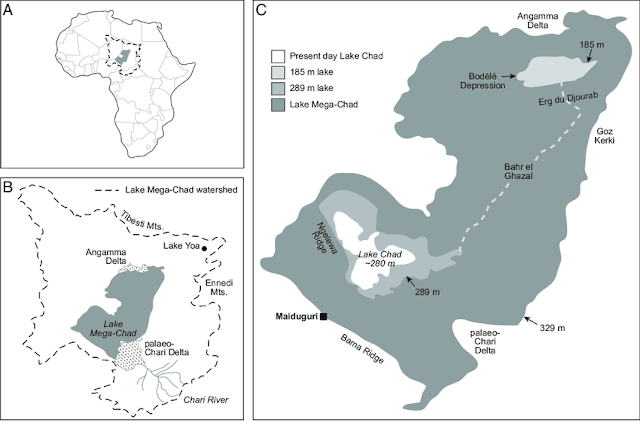Agriculture II - farming developments
Communities in the Lake Chad region have been adapting to climate change for decades or even longer by focussing their energy on different sources of income as the lake level changes seasonally, annually or over even longer timescales. Research from the WWF shows that many villagers in the Lake Chad region have shifted from relying entirely on fishing, to a more flexible approach to agriculture through farming the land surrounding the lake (Gawler 2018).
Pastoralism
Climate change has had a large impact on pastoral farmers in the Lake Chad region. The ‘Small Lake Chad’ phase disproportionately disadvantages pastoralists who might have to travel over 50km to the waters, a problem which doesn’t affect fishermen or farmers to such a great extent (Okpara et al. 2016). The FAO are trying to mitigate the effects of climate change on pastoral farmers but with limited success thus far (Nguyen 2017). A recent UN news article described how 80 people died in Nigeria as a result of clashes between farmers and nomadic herders in June of this year (Abubakar 2018). Societal disturbance and particularly pastoral agriculture seem to be intimately linked in the region and hence the effects of climate change on Lake Chad extend further than just the fishermen and farmers.
Crops and irrigation
In adapting to a less extensive Lake Chad, former-fishermen have started relying more on planting crops in the moist, fertile soils around the perimeter of the lake (Courcoux 2011). Crops which do not require irrigation or the addition of fertiliser are favoured and these include rice, sorghum, plant corn and cowpea (Courcoux 2011).
Figure 1: Shows a group of men and women sorting red peppers for export.
Source: IRD
Interestingly, red peppers are a popular crop in the region (Figure 1) and are often referred to as ‘red gold’ in Niger (Campagne and Begum 2017). Over 300,000 people are thought to rely on the cultivation of red peppers and fishing to make a living in Niger. However, the Boko Haram crisis has reduced the potential of the red pepper market as a viable source of income for farmers in Niger as the area has become heavily militarized. This has meant that although growing the red pepper industry is desirable, social factors involved have meant that traditional crops are still favoured in many regions.
Coe and Foley showed that irrigation accounted for 5% of the 30% decrease in the size of Lake Chad from 1966-1975, with aridification accounting for the other 25% (Coe and Foley 2001). The Komadugu Yobe River basin makes up 35% of the Lake Chad Basin (LCB) and flow in the river has fallen by 35% due to increased irrigation and dam construction in the 1970s (Barchiesi et al. 2013). In addition to reducing river flow and probably as a result, the construction of dams and irrigation infrastructure in the LCB was branded as a ‘complete failure’ by the WWF as the it was considered to be inappropriate for the regional climate (Gawler 2018).
The future of agriculture
Figure 2: A women nicknamed 'Banaa' pours spirulina collected from Lake Chad into a bucket to be processed.
Source: gettyimages
The production of spirulina, also known as blue algae, is growing in popularity in the LCB but is currently still a niche form of agriculture (Gawler 2018). In 2010 the FAO reported that the nutrient-rich algae, known locally as Dihé, is a substantial source of protein, iron and betacarotene so is considered a rich dietary supplement (Matthews 2010). However, the algae can only be grown successfully in brackish pools which characterise the north-eastern shores of the lake. Hence, although spirulina production can provide a source of income for some communities (and primarily women as shown in Figure 2), it does not a have the potential to be a basin-wide agricultural solution to unreliable agricultural income at this time.
A blog post on socialprotection.org last year by Oladayo Awojobi highlighted the following plans which have been established in order to mitigate the effects of climate change on farming in the LCB (Awojobi 2017). The German Federal Ministry of Economic Cooperation and Development (BMZ) and the Lake Chad Basin Commission (LCBC) are working together to implement an integrated water management system. In addition, the Lake Chad Climate resilience plan was established in order to manage governance of the basin’s shared resources, importantly including water. The future of agriculture in the LCB remains uncertain. Although the flexibility of agriculture in the region is increasing, so is climatic variability, making it even more difficult for people to adapt to inevitable environmental change.





Comments
Post a Comment